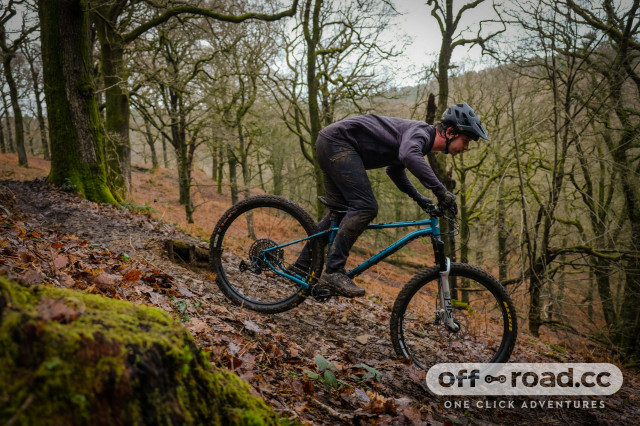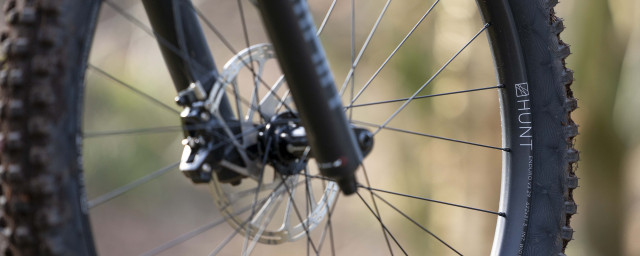
- Composed ride on descents and climbs
- Solid built kit
- Good value
- Not so confident on flat trails
- Rear tyre isn't massively grippy
The Stif Squatch is a full aggro 29” hardtail that eats descents for breakfast, while getting you back to the top efficiently and comfortably. Its fairly extreme focus means it's not quite as comfortable over flat trails, but for winch-and-plummet fun it's fantastic.
- Ragley Marley 1.0 review
- Shand Shug frame review
- Five reasons why you should have a hardtail in the fleet
Here we have the Stif Squatch in its priciest build, the AM 200. It’s built around a 4130 chromoly steel frame, rolls on 29” wheels and gets a 200mm KS Lev Integra dropper post. Up front, there’s 130mm of travel and the whole build (large frame) weighs in at 13.3kg.
Stif also does the AM 175 version, which gets the exact same kit but has a shorter (175mm, funnily enough) dropper post, plus a basic AM build at £1,900. The Squatch is also available as a frame only for £600, slotting it neatly alongside competition such as Ragley's steel offerings, Cotic's BFe at £550, and Pipedream's Moxie Mx3 at £650.
The Squatch’s steel frame gets external routing for brake lines beneath the downtube, and an internally-routed dropper post. The external routing on our test bike is not the neatest, being held together with a collection of cable ties rather than neat clamps such as on the Ragley Marley 1.0, but it gets the job done.
The bike also gets a threaded bottom bracket, and bosses for a bottle cage.
Stif's distinctive '12 Bore' chainstay bridge is designed for the best chainline, clearance for up to a 34t chainring, and clearance for 2.6” rubber out back. Stif also says it’s key in allowing the short 430mm chainstays.
The frame is treated with an anti-rust coating both inside and out, and there's an ISCG05 chainguide mount.
Those aren’t the only neat tricks Stif has up its sleeve. The seat tube angle is measured with the post at full extension, meaning 78° is the slackest it will ever get (unless your legs are super long and you fit a post with even more travel, though few even exist).
What that also means is that as the saddle drops, the seat tube effectively steepens, something that should suit shorter riders better – or so Stif says.
On our top end build we get a top end fork: a RockShox Pike Ultimate. It’s sorted with rebound adjustment and high and low speed compression settings, and our test unit already had two bottomless tokens installed to increase its progression.
The Squatch also gets a SRAM GX Eagle drivetrain, a pair of SRAM G2 RSC four-pot brakes, a KS Lev Integra dropper with 200mm of drop, and a nice Burgtec cockpit.
Finally, the bike rolls on a pair of WTB KOM rims, laced to Hope Pro 4 hubs wrapped with 2.6" Maxxis rubber: a Minion DHF with EXO casing at the front, and a Rekon with a tougher EXO+ casing at the rear.
As I tested this bike through some pretty wet conditions, I swapped the Rekon for a 2.4” Maxxis Dissector – but we’ll get onto that shortly.
Climbing
Stif says the Squatch is designed to get as much descent in as possible, so it’s built to be a solid climber – and it definitely is.
Its very steep 78° seat tube places rider weight almost directly over the bottom bracket which, when the gradient pitches up, results in a really comfortable and efficient pedalling position.
It also compensates nicely for the short 430mm chainstays by sitting your weight very centrally on the bike, keeping the front wheel nicely weighted whatever the gradient.
Singletrack
That steep seat angle does come with something of a trade off, though. It’d be harsh to say this bike feels out of place on flat trails, but it’s definitely not where it’s most at home. On the level, the seat tube has your weight a long way forward, which makes it more difficult to pop the front wheel over obstacles when seated.
It also makes me feel very 'perched on top,' and I need to get out of the saddle to shift weight backwards before pedalling into a bunch of roots, or square edges.
Once out of the saddle the 480mm reach offers plenty of room, making mellower trails well within this bikes capabilities. It’s spritely on the pedals, too, and the 430mm chainstay shines – it's a lively and flickable ride, despite the 1238mm wheelbase and big wheels.
The bottom bracket is pedal-strikingly low at 293mm and, when paired with the bike’s length, offers a super stable ride in corners. It does take an extra bit of muscle to tip in, but fans of longer bikes will already be used to this.
I do find pedal strikes come in their droves, but you learn to work around it – and it's always the trade-off for low-slung stability, rather than an issue with the Squatch per se.
All in all though, the Squatch is really only designed to go up or down. Simply going 'along' really isn't its forte.
Descending
Drop the saddle, point it downhill and the bike comes to life. It’s incredibly composed, and that’s only helped by the noticeable compliance of its ovalised seat stays. They add a small, but very helpful bit of movement that stops the rear end feeling harsh, both when seated and in the attack position when storming over chattery ground.
Some may think 130mm of travel a little thin for an aggressive bike, but it proves a really wise choice for the Squatch. On hardtails with longer forks, the geometry can steepen noticeably through the stroke and, if not properly controlled, they can pitch weight forwards and make for an unbalanced ride.
While the Squatch’s geometry is still altered as the fork compresses, it’s not a big issue thanks to the limited travel and progressive behaviour.
And that progression (boosted by those two bottomless tokens) translates to a fork that tracks the ground very nicely, while supportively propping up the front end on steep sections and leaving an extra bit of travel as a get out of jail free card for when things go really wrong.
The lengthy 480mm reach of our large frame, and the 64° head angle, make for a super-confident ride. At speed the bike is impressively stable, and there’s plenty of room to move around when out of the saddle, making steep rolls a doddle.
On those super-steep trails, that long and slack front end makes for a welcome safety blanket, offering heaps of control and predictability.
Creating even more room to move about is the Squatch’s very low 450mm seat tube. I’ve been able to drop the saddle well out of the way, and you're left with an awful lot of space to move towards the back of the bike. It's a very comfy weapon on the steeps.
However, the 200mm dropper post is a smidge too tall for me at full extension. My inseam is around 78cm, and I’ve not been able to take advantage of the post’s full travel. If like me, you’ve got shorter legs, it’s definitely worth considering the PRO 175 model.
Re-tyre it
Back to that Maxxis Recon rear tyre. While it fits perfectly with the ‘get up a hill easily’ mentality, it’s quite a burden downhill. Its rather low profile tread is fast rolling but seriously limits braking power, and it’s very easily overwhelmed in the wet. Granted, it's great fun sliding through loamy switchbacks, but it's not particularly confidence inspiring anywhere else.
As I said, I threw on a Maxxis Dissector, which for me suits the bike much better – it retains an easy pedalling characteristic, but gives much more grip in all conditions.
Value
Yes, £2,500 is a lot of money to throw at a hardtail, but for what you're getting the Squatch represents pretty good value. Competition comes from the likes of the Ragley Blue Pig Race and Ribble HT 275 Pro, and though they're both cheaper – the former by £200 (for the 2021 model) and the latter £300 – their builds aren’t quite as sorted, and their geometries aren’t as progressive.
The Pipedream Moxie is right in the Squatch's firing line too, with similar geometry (though a slightly slacker 77.5° effective seat tube) and a competitive build, but that's more expensive at £2,900.
Furthering this bike’s value and, of course, its sorted build are the easily serviceable Hope Pro 4 hubs and the extra-nice Burgtec finishing kit (the grips especially are lovely).
It’s also tough to find a hardtail elsewhere with geometry this extreme, so if this is what you're after that's worth factoring into the price too.
Overall
The Stif Squatch is a truly aggressive hardtail, built especially to be ragged down any descent at full chat while staying super pleasant when cranking yourself back up.
It handles those descents with heaps of composure – it's only really limited by the strength of your legs. Uphill, it’s a comfy and easy going place to be as the mega-steep seat tube makes light work of smooth climbs.
It's not particularly happy if you split the difference and ride on flatter singletrack, but if you're a hardcore hardtail fan the Squatch's aggressive ride will keep you happy in the techiest of terrain.


























Add comment